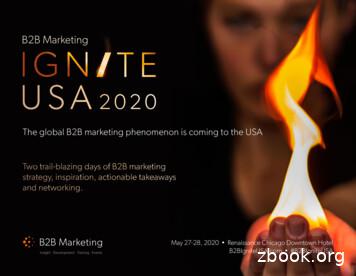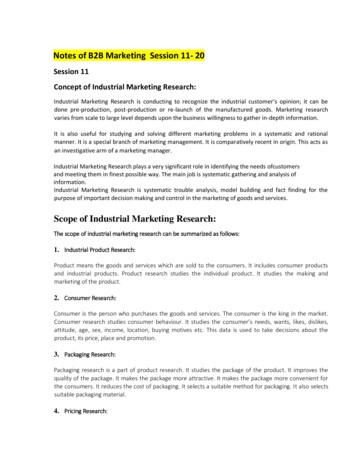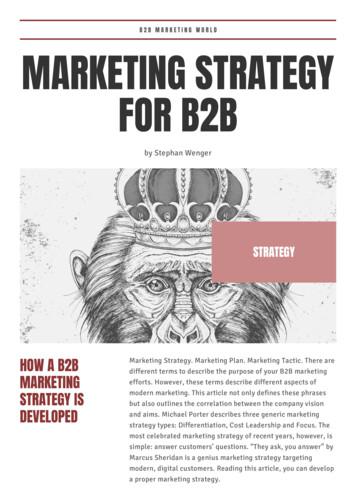B2B Customer Surveys - Pmgco
B2B Customer SurveysUnique Aspects of B2BMarketing and ResearchPriority Metrics GroupHelping businesses grow through insightSouth Carolina New York Londonwww.pmgco.com
The Business-to-Business (B2B) sector is different in fundamental ways from the Business-to-Consumer(B2C) sector. This paper explains those key differences and draws implications for B2B marketingresearch.In many cases, B2C transactions occur through an intermediary such as a retailer or agent. B2B refers totransactions that take place between businesses. As such, they are typically upstream from consumertransactions. If we envision the value chain for any product from raw material through consumer, theB2B space includes transactions within the first three steps: raw material, manufacturer and distributoror retailer.Depending on the form, many products or services are virtually always sold at one step in the valuechain. Toothpaste, for example, is essentially a B2C product although the components of the toothpaste– the chemicals comprising the paste itself and the package it is contained in – would be captured in theB2B space. Plastic resin is essentially a B2B product. Software is a good example of a product that can goeither way.
There are eight key criteria that distinguish B2B and B2C markets. These criteria also have implicationsfor how research is conducted: Length of sales cycle,Product complexity,Size of market,Pricing,Marketing approach,Buyers’ product knowledge,Use of market research,Channel complexity.We will discuss each of these in turn.1) Sales CycleThe B2B purchase cycle is an extended process, often lasting several months or longer. Marketing to B2Bprospects requires different actions, depending on what stage of the buying cycle your prospect is in.Using the Marketing Sherpa results, the average B2B sales cycle is 5.7 months. For consumers, the cycleis often measured in moments. According to a recent study completed by Daedalus Millward Brown, anaverage of 56% of consumers knew the brand they wanted to purchase before leaving home for a rangeof products from soft drinks, beer and milk through sausages, chocolate and mineral water. The balanceof 44% decided on the brand choice in front of the shelf.1Researchers should recognize this difference in the construction of questions. For example, it is criticalto understand how the decision process evolves for a B2B product, how information is gathered onpotential vendors and products and who selected the vendors to include, who is involved at various1http://www.daedalus.ro/files/decision process 2010 eng.pdf
stages, who makes the final decision, how does the process change after a vendor is selected the firsttime, and so on. These questions have a different relevance in the B2C space.2) Product ComplexityB2B products are frequently elements or components of products that will be further processed andthey are being purchased at a scale that greatly enhances the risk of a poor decision. Consequentlybuyers are concerned about technical details such as product composition, raw material sourcing, typeand cost of production processing, inventory methods, quality control procedures, etc. While consumersare free to have the same concerns about the toothpaste or any other product they buy and accumulatethe same level of technical knowledge, they do not have the communication channels nor thepurchasing leverage to act on these concerns.While both types of buyers may consider a similar set of high-level attributes in the purchase decision,the level of detail and complexity differs markedly.Typical Attributes of Concern: B2C Compared to B2BAttributeBrandFamiliarityProduct FormPreferencePackagingFunction, AppearanceBenefitsMeet ExpectationsValuePriceRetail PriceCustomer ServicePromotionConsumer AccessCoupons, SpecialsToll-Free Number, WebsiteDeliveryAvailabilityIn Stock or Out of StockProduct AttributeB2CTechnical LoyaltyB2BHistory, CorporateCommitmentMarket Demand, SupplierQualityProtection in Transit, Cube,Billboard (Shelf),Regulatory Req’mtsMarket Demand, ProductFormulationCompetitive Price,NegotiationsNAOrder Entry, Order Status,Shipment Information,Customer AdvocacyLead Times, On-Time,Paperwork, Back-OrdersAvailability, KnowledgeLevel, EffectivenessAvailability, ProfessionalismSatisfactionNPSB2B products are often linked with services. In some B2C markets (for example consumer electronicsand durable products such as appliances or automobiles) consumers will frequently be offeredsupporting services and warrantees. B2B buyers are more likely to expect or even demand theseservices. It is costly if a machine used in production is not functioning properly so technical support and
on-site services are critical. If a raw material does not combine or process as it should, the result can bedowntime, poor quality or returned product so sales and technical support are expected. B2B buyersexpect the right product and the correct amount to be delivered on time. Customer support, deliverystatus and communication are expected to make sure this happens and to keep the customer informed.As a result, B2B value propositions are complex. These differences should be articulated and deliveredthrough targeted and compelling communications. Research must reflect the product complexitythrough detailed and properly worded performance attributes that capture key aspects of productperformance and service support.3) Fewer Identifiable BuyersAccording to the 2008 US Census, there are 5.9MM employer firms – firms that have a payroll. 3.6MMhave 1 to 4 employees and another 1.0MM have 5 to 9 employees. It is likely that at these firms, oneperson is making most of the purchase decisions. At the 1.3MM firms with 10 or more employees, if weassume an average of 3 people involved in the purchase decision process for a given product, thatequates to 3.9MM decision makers. Added to the decision makers for the smaller firms, that leaves uswith a total of 8.5MM B2B decision makers in the US.Also from the 2008 Census, there were 299MM non-institutionalized residents of the United States. Ofthose, 238MM were 15 years of age or older, representing 80% of the population. Assuming that theseare the consumer decision makers (although certainly children are the sole decision maker or influenceron many products), B2C decision makers outnumber B2B decision makers 28 to 1.B2B buyers are also more challenging to locate. The Pareto Principle states that 80% of effects derivefrom 20% of the causes. In this case, the Principle suggests that 80% of revenue comes from 20% ofcustomers.In the B2B world, all customers are not equal – some are more important than others—and unlike B2Csampling, B2B surveys sampling designs should be biased. Samples should include a proportionatelylarge percentage of large customers to more accurately reflect the revenue mix of the customer base.Secondly, research must recognize that some individuals within a customer have more influence in thepurchase decision than others. It is not enough to identify customers, we must identify the purchaseinfluence within each customer.4) PricingThe price of the same size and brand of Colgate toothpaste may vary by 10% depending on the store,perhaps a bit more in c-stores or in remote locations. Prices of B2B products can, and often do, differ bysegment, geography, distribution channel and by customer. B2B products are less standardized and theprice varies by volume, purchase history, associated services, importance of the customer, otherproducts purchased, degree of customization, and many other factors. It should also vary by external orfactors such as switching costs and market dynamics such as competitive intensity.
B2B buyers tend to buy on value as opposed to price. They are better evaluators of life-time cost, costin-use or systems cost than consumers, and as such are generally willing to pay a premium price if it canbe demonstrated that the product will last longer, reduce costs, be more productive, or otherwise leadto a healthier bottom line.Data collection should reflect these differences incorporating questions on competitive pricing,negotiations and value. Analysis should offer corresponding insight into the multiple dimensions of priceand value and do so by market segment.5) Marketing ApproachMarketing is concerned with creating and maintaining demand – that does not differ between B2B andB2C markets. How that demand is created and maintained differs substantially. End consumersfrequently buy based on emotion or impulse, particularly in the world of fast moving consumer goods(FMCGs). In the B2B world, buyers tend to be more logical, evaluating a product on a defined set ofcriteria against competitive offerings. But other factors also influence the B2B buyer – for example, fearof making the wrong decision (and the potential impact on career), the level of confidence in statedperformance, and personal relationships and perceived obligations.Secondly, to the B2B buyer, corporate brands (e.g. DuPont) are typically more important than productbrands (e.g. Tyvek). Brands convey critical information to the buyer such as integrity, trust, confidence,history, fairness, quality, and professionalism.Lastly, B2B marketing messages are communicated more in person than through indirect means. Thesales force, customer service and technical support personnel all have explicit and implicit roles inconveying key messages such as those associated with the brand. Because of the smaller number ofbuyers and their relative importance, personal communication is cost-feasible and justified in the B2Bsector.Research recognizes and addresses these realities by including relevant attributes in questionnairedesign, focusing data collection efforts on key decision makers, varying questions and data collectionmethodology by the respondent’s role in the purchase decision process, and conducting analysis thatrecognizes the subtleties of B2B decision making.6) Product KnowledgeThe volume of B2B products purchased, their relative complexity, and the importance as a componentor element of the final product often results in the need for buyers to have substantial technical andoperational expertise. It is not unusual that purchased products represent 60-70% of the final sellingprice of a product. Consequently, B2B buyers also have detailed understanding of the cost structure ofsuppliers’ production processes.Because of these realities, B2B buyers seek a greater volume and detail of information, understandcompany capabilities and capacity in detail, develop scenarios of potential problems and likely response,
and thoroughly research alternative products. With such a formidable set of tasks, buying decisions arefrequently group or team decisions in which each member carries specific responsibilities and isincluded on the team for their unique experience and knowledge.Effective and accurate research must include the various influencers in a purchase decision and seek toconfirm and develop further insight into their respective roles. It is not unusual to gather survey inputfrom 5, 10 or even 50 individuals at one company to fully understand the customer-vendor relationship.A further important element for B2B surveys is a company-level analysis that – because of the small sizeof the universe – may not be a highly significant sample. In fact, statistics should be essentially ignoredat this level. If key individuals are included in the survey, great insight can be gleaned even when thesample size is not large enough to ensure statistical significance. If those same key individuals are notincluded in the survey, the results may be rendered effectively useless.7) Use of Market ResearchFor a producer of FMCGs, market research is a requirement to understand the potential sales volume fora product or the impact of a change in product formulation or package design. Retailers closely monitorsales volume of every SKU (stock-keeping unit) in their inventory. If a product is not generating sufficientvolume to justify the shelf space allocated to it, its shelf space allocation will be reduced or the productmay even pulled from the shelf altogether. In fact, many product categories and retailers will demandpayment for placing the product on the shelf – so called slotting fees. For these reasons, FMCGcompanies regularly conduct extensive market research – the cost of failure is too high.This is not the case with B2B marketers. Products are frequently introduced to the marketplace orexisting products modified with little or no formal market research. Often a new or modified product isthe result of one customer’s request and so the demand is already effectively ascertained.Market research in the US is a 20B industry2. According to ESOMAR, B2B market research firmscomprise approximately 8 percent of all market research firms and those with an industrial focuscomprise only 25 percent of those.3 If the number of firms corresponds to the revenue that suggeststhat B2B research in the US is a 1.6B industry. Spread across the 1.3MM firms with 10 or moreemployees results in an average annual company expenditure on market research of 1200.Valuable research can be conducted with a very small number of informed respondents. However, B2Bresearch does demand well-crafted, articulate and thoughtful design that reflects the knowledge andexperience of the respondent.8) Channel ComplexityAlthough the internet has created an alternative to the traditional brick-and-mortar retail channel formany B2C products, B2B marketers routinely manage much more complex distribution channels. It is2Market Research in the US: Market Research Report, IBISWorld, December hforum/#sthash.iaKc4RZe.dpuf3
not unusual to sell the same product line through master distributors, distributors, agents or brokersmanufacturers’ representatives, and even direct to end users. Each of these channels has differentinventory and service requirements, may have different packaging or delivery requirements, and willalmost certainly have different price structure.Typical Distribution Channel StructureTo understand and communicate with channel members, B2B marketers will frequently work with orthrough industry experts, trade organizations, trade shows, industry publications, data accumulators,and other third parties.It is incumbent that researchers understand a company’s channel structure to be able to provideaccurate and insightful results. Data collection should accommodate channel members’ position andrelative understanding of the product. For example, some channel members do not take title and maynot even physically handle the product. Others may take title and/or modify the product by breakingbulk quantities into smaller amounts suitable for resale, repackaging, holding inventory or other valueadded services.
The B2B purchase cycle is an extended process, often lasting several months or longer. Marketing to B2B prospects requires different actions, depending on what stage of the buying cycle your prospect is in. Using the Marketing Sherpa results, the average B2B sales cycle is 5.7 months. For consumers, the cycle is often measured in moments.
B2B Marketing magazine subscription. › Annual events for B2B marketers: B2B Marketing Ignite USA and the B2B Marketing US Awards Go to b2bmarketing.net to find out more About B2B Marketing. Get in touch Alex Burton Customer care manager E: alex.burton@b2bmarketing.net T: 44 (0)20 7014 4920 B2B Marketing
Cleo Jeans B2B 839 H Communion Collection (The) RC 721 Coolman Trading B2B 243 Cooper & Nelson RC 305 Copen Sportswear B2B 443 CounterattackB2B 726 H Cre Brand B2B 730 Culture Jeanswear B2B 931 D-LUX B2B 338 D’Italia RC 1315 Daniel Ellissa RC 100 H Darring VIA 1009 David X RC 609 Deals Wholesale B2B 935 & 938
Boom Boom Jeans B2B 639 Boyle Heights B2B 744 Boys Nautica B2B 425 Braveman RC 105 Brian Brothers B2B 342 H Brio Milano RC 207 Bruno Conte RC 809 Brutini NRG 645 Bryan Michaels RC 707 BTL B2B 116 Budabean B2B 335 Buffalo Jeans VIA 900 C.K.L. RC 212 C.O.D. Friendly CONCOURSE the BRANDs H NEW AT THE COBB
Base: 110 B2B online sellers Source: Q2 2015 Forrester/Internet Retailer B2B Sell-Side Online Survey 73% 44% 42% 36% 34% 24% 21% 19% 15% 30% 29% 19% 22% 20% 12% 15% 12% 23% 25% 35% 36% 45% 53% 36% B2B website Smartphone Tablet 3rd party partner B2B websites 3rd party partner B2C websites Call center/phone B2B print catalog In-person (store .
Access Forms & Surveys The Forms & Surveys Workspace is where you create and manage forms and surveys. Each Site, Subsite, Channel and Section Workspace has a Forms & Surveys Workspace. You can access Forms & Surveys two different ways, through the Tools tab and by clicking Forms & Surveys in Common Tools. Access the Site Workspace Forms & Surveys
B2B Marketing Session 12 , 13 and 14 B2B Marketing Strategy Process: 1. Start with customer research 2. Conduct qualitative and quantitative analysis 3. Establish key objectives and metrics 4. Develop your B2B customer journey map 5. Identify executional marketing tactics For B2B companies, the potential buyer pool is typically smaller and less .
the marketing plan. B2B MARKETING WORLD Step #1 - Define marketing aims Step #2 - Analyze the status quo Step #3 - Define your target group and buying center personas (BCP) Step #4 - Describe the customer journey. Your B2B Marketing Tactic. The 6 steps to create a marketing strategy in B2B are: The marketing aims are derived from the .
--Russell, S. J., & Norvig, P. (2016). Artificial intelligence: a modern approach. Malaysia; Pearson Education Limited. Intelligence is the computational part of the ability to achieve goals in the world. It is related to the similar task of using computers to understand human intelligence, but AI does not have to confine itself to methods that are biologically observable.--By Prof. John .























